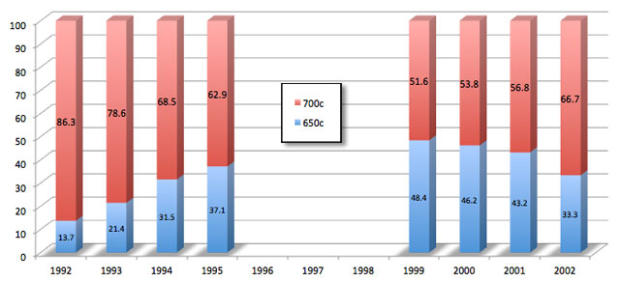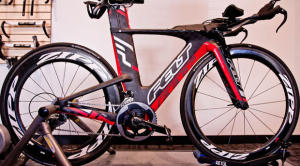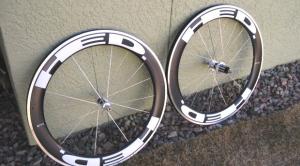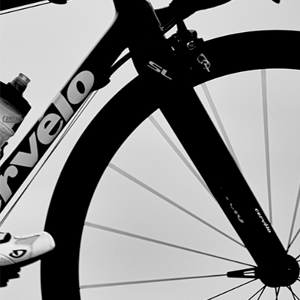This is the third installment in our series on, “Bikes you should’ve bought but didn’t (or might still buy but probably won’t).”
I’ll probably harsh some highs today, irking and disenfranchising some of my own direct customers (coaches, bike shops and bike makers). But I’m irked too, because I’m tired of those in industry who feel they’re overlooked, unappreciated, or in a hole, but I watched them dig the very hole they’re now in!
The modern era of triathlon, technologically, began in 1987. This was the year of the wetsuit and the aero bar. Once aero bars made their way onto road bikes some problems became apparent. Riders wanted to move their saddles well forward, and did. Cockpits became more cramped (than on road bikes) and the head tubes of bicycles were forced lower. The chain stay distances on tri bikes shortened and the front/center distances (bottom bracket to front wheel axle) lengthened.

The front wheel badly wanted to become smaller, especially for smaller riders, in order to get the aerobars low enough and to bring the aerobars sufficiently back toward the rider (because of that cramped cockpit). Bikes below 53cm in size needed to have a 650c wheel in the front and for convenience sake it makes sense to make both wheels the same size. (With the advent of threadless headsets, then internal headsets, today that over/under threshold is probably around 50cm.)
When I began making tri bikes in 1989 I knew the 650c size wheel worked fine. It was fast, and it was geometrically correct for smaller riders. I knew this because the very first bikes I made were women’s specific bikes, which I began making in 1988, which I made with 650c wheels front and back. That trend caught on, and above you can see the rise in 650c bikes in Kona throughout the early years, and then their eventual fall during the 2000s in Kona. This graph doesn’t detail the use of 650c in bikes ridden by women in Kona; but of all bikes in Kona.
By the end of the '90s half the bikes on the pier in Kona had 650 wheels! I remember the neutral support van following the men's front pack radioing in a panic, because Dave Scott was in that pack and they had no 700c wheels in the van (and they didn't need any, except for Dave).
If you take as axiomatic that there is a perfect size for the 700c wheel, what would it be? 55cm? 54cm? About the average size of a European male cyclist a century or more ago, when that wheel size was chosen? If you reduce that bike exactly, proportionally, in every way you’ll get a 650c bike in size 49cm.
So here we are 30 years later and the 650c wheel is getting “discovered”. Emma Pooley, world champion time trialist, silver medalist in the Olympics, and with a PhD in engineering, facepalms at the idiocy of the bike industry. She has joined forces with a custom bike maker to sell 650c bikes to women who share her 5’2” stature (like the Cervelo on which she won her world championship: with 650c wheels).

Smaller wheels seemed to worked well for Paula Newby-Fraser, when she won the Ironman World Championship in 1991 (she won that race on a bike with 24” wheels). She moved up to dual 26” (another way to label 650c) and won in ’92, ’93 and ’94. Karen Smyers won the race on 700c wheels in 1995, after Paula fainted 300 yards from the race finish. Paula outrode Karen by 12 minutes that day (on 650c wheels). Paula won again in 1996 on smaller wheels and in most cases throughout the ‘90s most of her competitors were on smaller wheels too, including 2nd place in that ’96 race (Natascha Badmann, above), perennial 3rd place finisher Fernanda Keller, 2nd place in ’92 Julieanne White, and on and on. Lori Bowden, Heather Fuhr and Natascha Badmann won the rest of the world championship races until 2005, when 6-foot-tall Michellie Jones won the race on a 700c-wheel bike. I think only once in 15 years before Michellie’s win was the women’s race in Kona won on a bike with wheels larger than 650c.
Were 650c wheels faster? Debatable. But the bikes fit and handled better for riders under 5’5”, and they were more comfortable, because of the gyrations one must go through in order to make a 700c bike fit a smaller woman.
Are 650c wheels slower? Perhaps we should go back and ask the shorter-statured women who didn’t win the Hawaiian Ironman WC during those 15 years, who chose 700c bikes.
I got so tired of hearing the made-up, factless lies about 650c wheels I bought one of my sponsored duathletes (Liz Downing, below) a USCF racing license, took her to a 40k time trial, where she raced her first, last and only bicycle race of her life. She broke the existing women’s national record by a minute-and-a-half. On a bike with 650c wheels.

I learned that Giant’s Liv brand released "Avow, the first truly women's-specific triathlon bike.” Do tell! "Cassandra Chou is a Liv Global Category Manager,” we read, "which means she designs Liv’s bikes from the ground up for women. Cassandra is also very petite, at 155 cm (about 5’1”). Four years ago, she began racing triathlon for fun and gradually became more interested in the sport. However, she has always had to compromise when it comes to bike fit for her races.”
The solution? “Placing a 650c wheel in the front.” Who knew! She decided to put a 700c wheel in the rear, which I think is a mistake, the same mistake Georgina Terry made in the mid-1980s when she made her bikes with 24” wheels in the front and 700c in the back. Nevertheless, we keep seeing reinventions of the same idea and that’s because of the problem we have fitting smaller people aboard 700c wheels.
Here we are, 30-plus years after the Terry, right at 30 years since the dual-650c bikes I made for women, and the narratives like this from Liv describe the Aha! moments. Last month I read an article about actress Mayim Bialik who, "Is Sick Of People Calling Women ‘Girls’.” I think I get it. But Ms. Bialik is 5’4” and if she's riding around on a 700c tri bike, she’s going to bear the discomfort of a verbal slight for an hour, and the discomfort of a physical slight for as long as she owns and rides that bike. Where is women’s advocacy when an entire industry systematically and purposefully makes products that disenfranchise those who have the bad sense to stop growing before they hit 5’5”? (But it isn't all the industry's fault, which I'll get to in a minute.)
Slowtwitchers know this. "Do you feel that 650c (26" wheel) bikes for road and tri are best for people of shorter stature?” I asked two weeks ago. Half of you said “yes,” but that the product is unavailable. A fourth of you said “yes” and the product is available. A fourth of you said “no” and to that fourth of you, I love you, but you’re just flat wrong.
To the half who said the product is not sufficiently available, whose fault is that? Not the bike companies’ fault. Cervelo, Felt, QR, Trek, Kestrel, Cannondale, and many more used to make these bikes, both as road bikes and tri bikes. You didn’t buy them. The market didn’t want them. Mind, some of the very same companies that make 700c bikes for sale in the U.S. make these bikes in 650c for the Japanese market today! Why don’t they import them into the U.S. market? Because you won’t buy them.
Who’s to blame? First, to the very buyers and users of these bikes. My wife impresses me as the smartest, most thorough shopper I know. It is not that the shorter half of the women’s market does not have the capacity to educate itself about products on offer. These buyers just have chosen poorly when it comes to tri bikes (and road bikes, for that matter). Not only have they not demanded the product, they haven’t bought it when it was sitting right there on the showroom floor.
Second to blame is whomever it is who’s advising these customers. If you advised your 5’5” or shorter wife, girlfriend, friend, daughter to buy a 700c tri bike, you advised poorly. If you are a coach and you advised in this way, you failed your client.
Third, the shops that sell these bikes. If you’re one of these shops, don’t blame Canyon for your woes! Don’t blame Amazon! Understanding what your customer needs, when that knowledge is nuanced or not common, is the reason why you exist! If you’re not able to provide the service and knowledge that mail order and mass merchandising can’t provide why are you needed? You had your chance. You muffed it. You swung. You whiffed.
But it’s not too late! I keep writing this benchmark: 5’5”. The average height of an adult woman in America is 5’4” (and I expect the median height is similar, which means half of all women triathletes should be on 650c. If you’re 5’7” (Karen Smyers), 5’10” (Leanda Cave), 5’7” (Chrissie Wellington), 5’9” (Daniela Ryf), you don’t need a 650c bike. It’s understandable why you didn’t use a 650c bike when you raced and won Kona. In my opinion, Mirinda Carfrae (5'3 1/2”) is a marginally better fit aboard a 650c bike, but she has won Kona on both wheel sizes (below).

When our 650c poll was running last week Cervelo co-founder Gerard Vroomen emailed me. Referring to the half of you who believe 650c is the right size but it’s not sufficiently available he wrote, “So people think 650c is the right size for small riders but the product is not available. But if you make the product available, they won’t buy it.” This used to drive him crazy as a manufacturer.
Here’s how you know that an idea is good: The idea presents itself, the product arrives, and the know-nothings, the retro-grouches, the lazy thinkers, the fearful shout it down and it goes away or sells meagerly; only to reemerge! That happened to the slant parallelogram derailleur, the clipless pedal, electronic shifting. The lazy thinkers shouted down 650c and – lo! – Liv “invented” a tri bike that fits women well because of the use of a 650c wheel! While Liv might be naïve to the history of this wheel (or reticent to acknowledge that they stand on the shoulders of others), the 650c wheel is going to keep coming back until it finally finds its rightful place.
Oddly, the timing might be good, because the know-nothings have done such a good job of drowning this wheel out that the enterprising manufacturer who understands the product, and makes it, could fine some open field running. Understanding this wheel (before direct sellers catch on) is precisely the kind of knowledge that gives bike shops reasons to exist. Maybe with the recent experience of 559 bead diameter MTB, then the 29er, then 27.5”, bike shops see that, yes, wheel size is a variable in play; that it can make a difference. Maybe this time around, if 650c makes a resurgence, bike shops will use this as an opportunity to get back off their heels, lean forward, and demonstrate their raison d’etre.
[Thanks to John Lillie for the Liz Downing photo.]



